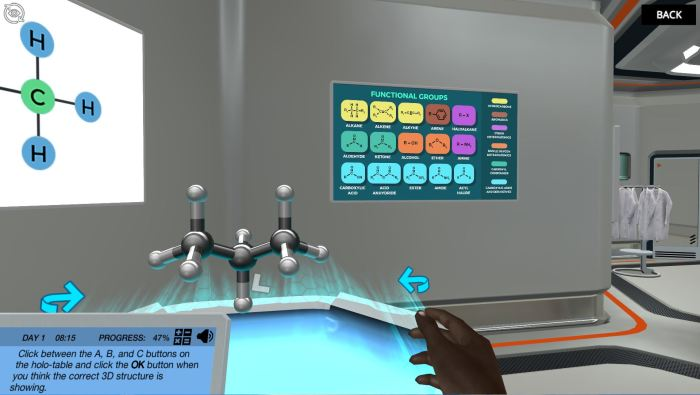
Hydrocarbons and hydrocarbon nomenclature are both core elements of organic chemistry. Indeed, learning nomenclature and structural representations of hydrocarbons can make the rest of organic chemistry a smooth ride for students. It can provide a solid foundation, ensuring that students find it easier to learn about reaction mechanisms and aromatic compounds.
However, nomenclature and representations can be confusing to understand and challenging to put to practice. Here, we list five engaging ways to teach hydrocarbon nomenclature and representations to help students learn.
Interactive models enable better learning of scientific concepts through a mix of tactile and visual stimuli. In organic chemistry education, interactive models further allow students to experiment with molecular structures and correct any mistakes in their conceptual understanding.
Take Labster’s hydrocarbon nomenclature and representations simulation, for example. Our simulation presents 2D molecular structures, matches them with their corresponding 3D holograms, and asks students to name these compounds. The students also learn the advantages and disadvantages of different molecular representations like chemical formulae and 2D structures.

Games and activities elevate classroom learning to a fun and exciting dimension and make any subject matter engaging for students. Plus, they help enhance the students’ memorization and recall abilities, which can come in very handy when learning organic chemistry.
For example, to teach hydrocarbon nomenclature and representations, you can engage your students in the following games and activities:
· Invite your students to play a nomenclature puzzle. You will provide them with different pieces of a hydrocarbon structure, which they will then assemble and name.
· You can design cards that have hydrocarbon structures and their chemical names on separate pieces of paper. Distribute the cards among your students and ask them to match each hydrocarbon to the right name.
Advanced technologies, like animation, simulation and virtual reality, can dramatically boost the effectiveness of organic chemistry education. For example, these technologies make it possible for students to seamlessly switch from one hydrocarbon representation type to another. They can also improve how students learn hydrocarbon nomenclature by clearly presenting 3D structures of organic molecules.
Labster’s hydrocarbon nomenclature and representations simulation, for instance, uses animation and holograms to teach students the structural representations of hydrocarbons. Our simulation also teaches the different formula types for organic compounds. Further, the students learn how to identify the best structural representation to use for a hydrocarbon. What makes this simulation even better is that the students can revisit these core concepts anytime at their convenience.

Discover Labster's hydrocarbon nomenclature and representations virtual lab today!
Whether they are high-schoolers or university-goers, your students are already thinking about their professional careers. Therefore, if you could give them a career-determining reason to learn a subject, they will be more invested in it. Use career exploration as a creative method to encourage your students to learn the fundamentals of hydrocarbon nomenclature and representations.
For example, tell your students how learning about hydrocarbon nomenclature is the first step towards accessing brand new avenues in high-impact fields like pharmacology and polymer science. Discuss how professionals in the energy industry need to know hydrocarbon nomenclature and representations to explore, extract, and process petrochemicals.
Students may find hydrocarbon nomenclature and representations too basic a topic to have any measurable real-world impact. It is important that educators correct this mistaken presumption in the classroom itself. Connecting your study topic to real-world applications can immensely motivate students to learn and respect the subject matter.
You can use this method to motivate your students to learn about hydrocarbon nomenclature and representations, too. Tell them how communication of life-saving drug development research will be impossible without appropriate nomenclature of the organic compounds involved. Discuss how nomenclature and representations are important topics to understand the organic compounds that pollute our environment.
Learning hydrocarbon nomenclature and representations is the first step towards exploring the wonders and intricacies of organic chemistry. The teaching techniques we have listed here can help your students learn and apply this topic in exciting new ways.
Try our free 30-day All Access Educator's Pass today and teach with the hydrocarbon nomenclature and representations simulation alongside 300+ other virtual labs!

Labster helps universities and high schools enhance student success in STEM.
Request DemoRequest a demo to discover how Labster helps high schools and universities enhance student success.
Request Demo